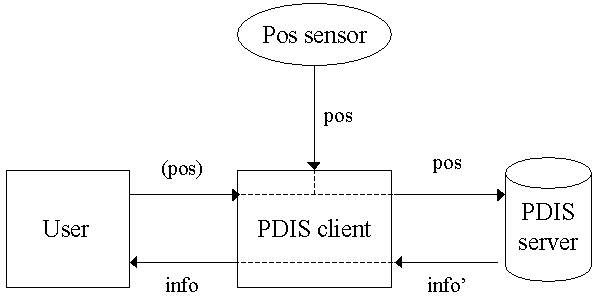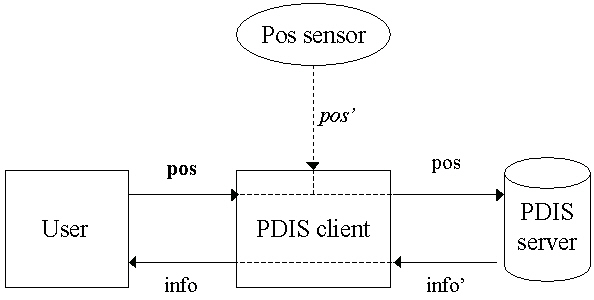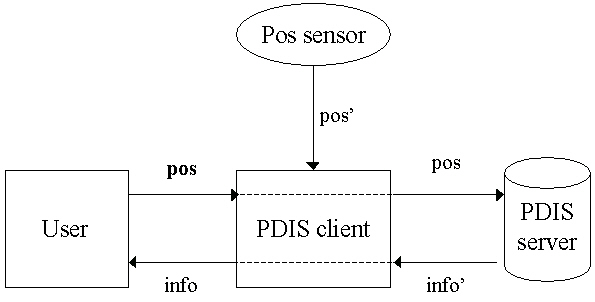
Position paper for W3C and W@P's
Workshop on Position Dependent Information Services
February 15-16, 2000, INRIA, France
by Odd-Wiking
Rahlff, M.Sc., senior research scientist,
Odd-Wiking.Rahlff@informatics.sintef.no
+47 2206 7426
Distributed Information Systems
SINTEF Telecom and Informatics,
P.O. Box 124 Blindern, N-0314 Oslo
Norway
A position dependent information system should always allow for manual positioning on the client. The reason for this is twofold: First, position sensors do not always work, or may work incorrectly. Secondly, the user will sometimes need to simulate being located at a physical position in order to access information as in a "virtual visit". Both of these situations need a simple mechanism for manual positioning. This is equivalent to defining the fallback solution of the position dependent information system as the rule, with exceptions accounting for the automatical positioning. Doing this will make the core functionality of such systems much easier to understand both for developers and users.
Our research institute, SINTEF, is the Norwegian partner in the Esprit Long-Term Research programme, HIPS, Hyper-Interaction within Physical Space, (1997-2000), one of the thirteen i3 (Intelligent Information Interfaces) connected community projects, where functionality for a tourist using an indoor and outdoor personalised position-dependent handheld device is investigated. In this project contextual information about artworks and places is presented to the user based on position data, GPS outdoors and infrared cones indoors. The positioning technology is challenging [1].
We expect the workshop to result in some common guidelines to developers of position dependent information systems, as well as an improved understanding of what upcoming standards may be. An important aspect of such systems will be the secure and safe storage and retrieval over time of life-long traces of interactions with personal wearable and contextual information appliances [2]. These personal traces will, we believe, become an integral part of our cultural footprints as more and more traces are interwoven. We would expect the workshop to also address the need for such storage.
We can contribute in the discussion of the role of contextual sensors in mobile devices, as indicated in the following sections.
A position dependent information service (PDIS) will typically correspond to the following architecture:

Figure 1: Basic architecture of a position dependent information service
Here, the user interacts with a PDIS server through a PDIS client, e.g. a handheld mobile wireless device. The physical position which is an essential part of the mobile user's changing physical context, is accessed through one or more position sensors.
Ideally, the physical positioning should work automatically and flawlessly; GPS should track the user outdoors, and infrared emitters or similar devices should be used to detect the physical position of the user indoors:

Figure 2: Ideal automatic positioning
In the real world, however, positioning technology is quite error prone. GPS requires direct line-of-sight to at least three satellites in order for the GPS receiver to be able to compute a position fix, leaving the user in positional darkness (or just at the last fixed point) in narrow streets or under branches of trees. Although additional sensors measuring inertia etc may be used to compensate somehow for these effects, in general the user will frequently be in zones where no position can be computed, and the system should therefore ask the user to pinpoint the area of interest manually. This could be done simply by moving an icon representing the point of interest on a map on the device.

Figure 3: Manual positioning, on location
A very similar condition occurs when the user would like to access information remotely, as e.g. a tourist would when sitting in Oslo preparing for a trip to Paris. This kind of virtual visit would have the user indicate the point of interest manually, while simultaneously cutting off any signal from the position sensor. A position dependent information system should therefore have mechanisms for allowing manual positioning, thereby temporarily suspending real-time automatic positioning.

Figure 4: Manual positioning, off location; virtual visit.
Note that in the case that the automatic positioning system cannot detect the position, the system has no way to distinguish between a manual position input on location, and a virtual visit to a relatively nearby off-location, unless of course indicated by the user on beforehand. Virtual visits and manual positioning are thus two sides of the same coin. We regard virtual visit as being essential to the user of such systems. Not only will this make PDIS systems more robust, it will also make testing and debugging much more easy to accomplish.
The insight this gives is as follows: A position dependent information system can preferably be viewed as a system that as a rule has to ask the user where the point of interest is. The user thus has to manually indicate his physical point-of-interest on a map (e.g. of a country, a city, an outdoor area, a floor plan of a building, or a room map) in order to access information pertaining to that location. Miraculously though, through various positioning technology, the system may actually do this point-moving automatically on behalf of the user. The work of the developers and the providers of the positioning infrastructure will of course be to bring the system closer to the ideal automatic positioning solution.
So, you may ask: Does this really mean that the user as a rule will have to input positions manually?! Of course not. Fortunately, positioning technology can make life much easier than that. But we believe that the manual input mechanism and the corresponding mental model of this basic interaction is useful both for the developers, as well as for the users which will get an improved understanding of the limitations as well as the possibilities of of such systems.
Rahlff, O.W, Rolfsen, R.K, Stegavik.
H., Where am I now, computer?, Workshop
presentation at i3AC-98, i3 Annual
Conference, Nyborg
Denmark: June 29th to July 1st, 1998.
Rahlff, O.W, Rolfsen, R.K, Herstad,
J., The Role of Wearables in Social Navigation,
Chapter 12 in Social
Navigation of
Information Space, p 217-236, Editors:
Alan J. Munro, Kristina Höök, David Benyon, 280 pages (August
1999), CSCW-series, Springer-Verlag
UK; ISBN: 1-85233-090-2.
Last updated on December 20th, 1999, Odd-Wiking Rahlff.